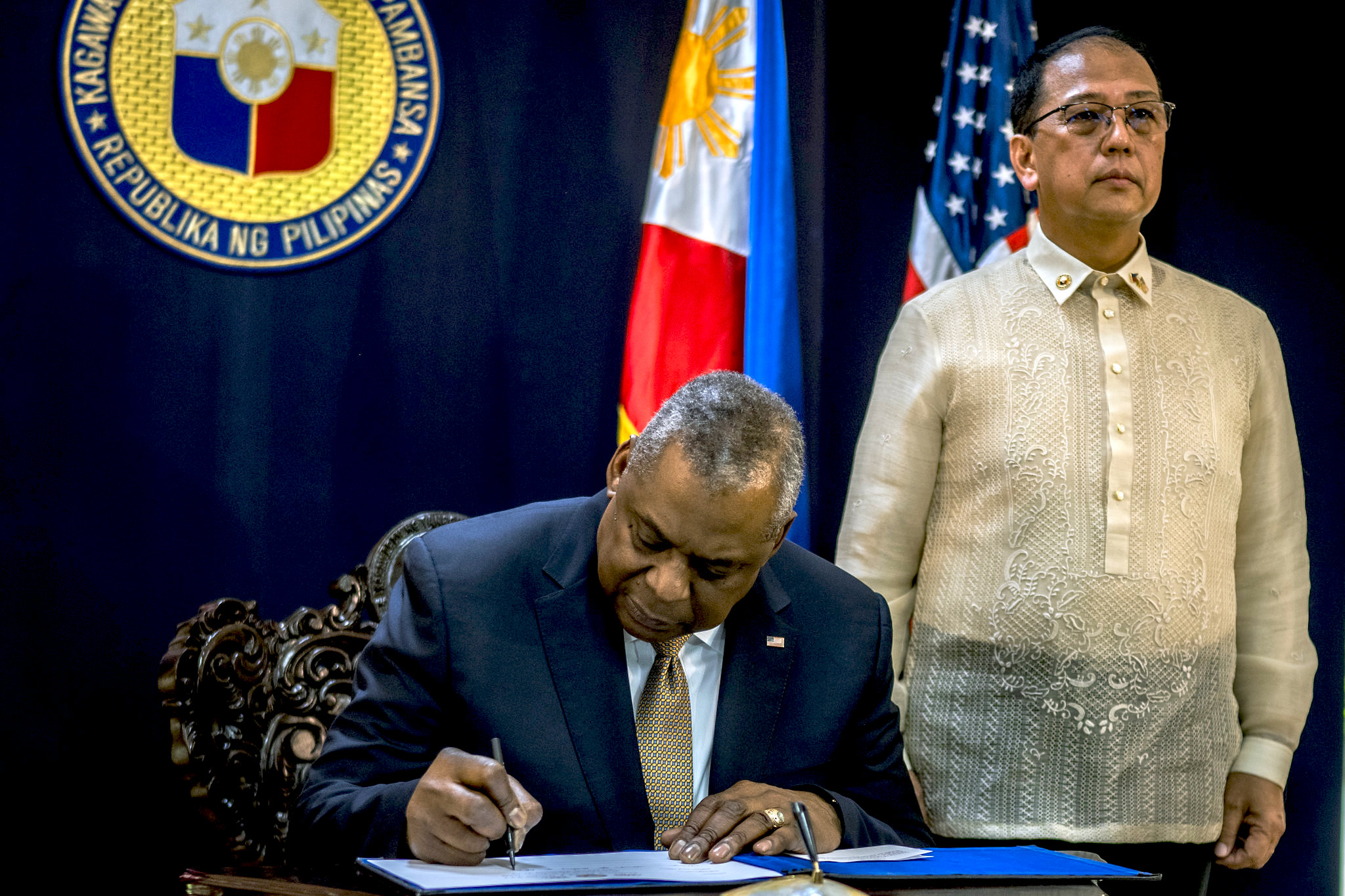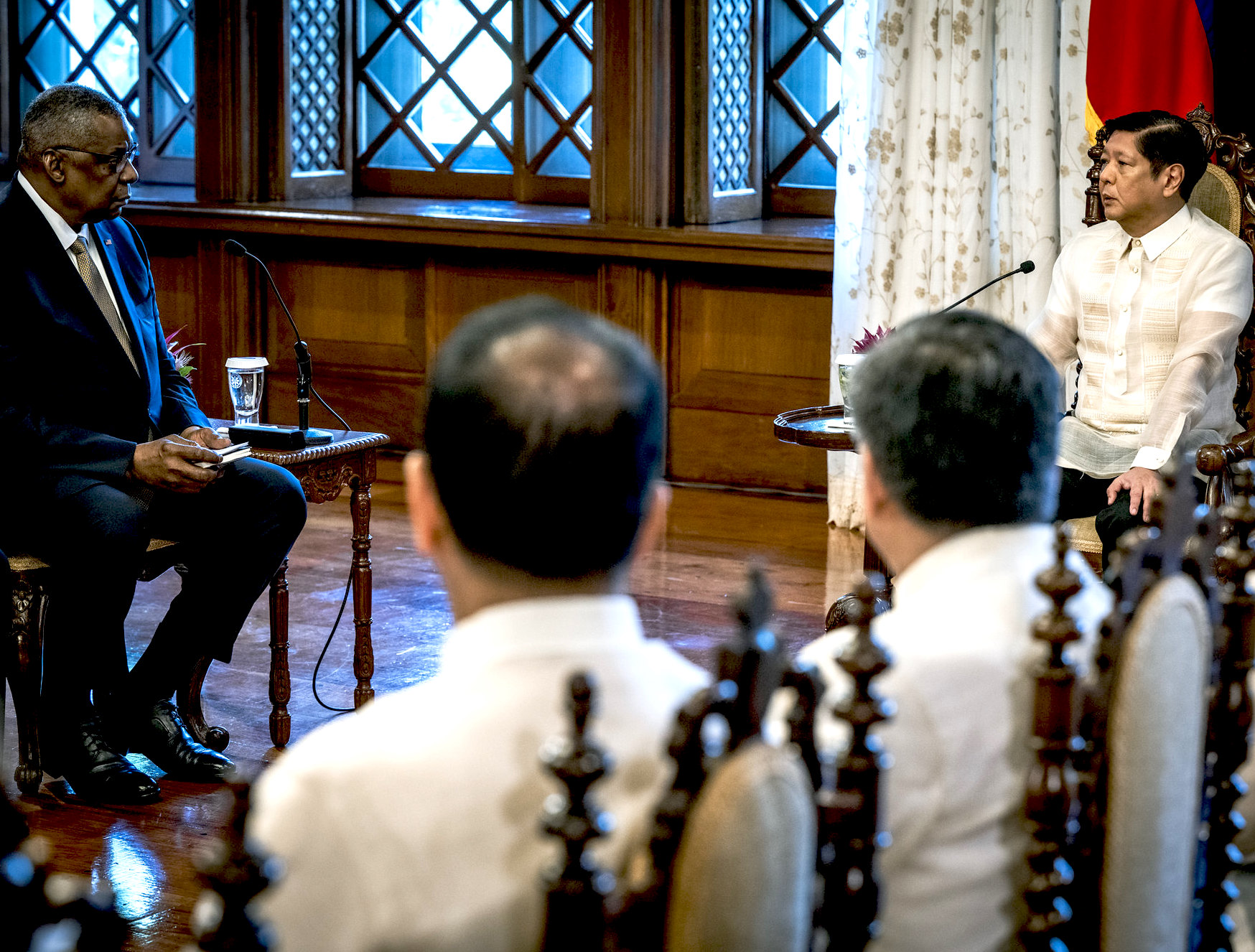The decision to grant the U.S. access to more bases — announced during the U.S. defense secretary’s visit — was decried by peace advocates as part of the Pentagon’s push into the Indo-Pacific, with an intent to encircle China.

U.S. Secretary of Defense Lloyd Austin signing a guestbook in Manila as Philippine Secretary of Defense Carlito Galvez stands on right, Feb. 2. (DoD/Chad J. McNeeley)
The Philippines agreed to give the U.S. military further access to more local bases across the country in a move announced Thursday by President Ferdinand Marcos and U.S. Defense Secretary Lloyd Austin in Manila.
The joint decision was widely decried by Filipino peace advocates, who see it as part of a months-long effort by the U.S. to expand its military presence across the Indo-Pacific, with an intent to encircle China. Protesters organized by left-wing and progressive groups gathered outside the presidential palace after the announcement.
“The matter of asserting Philippine sovereignty and sovereign rights rests with the Filipinos, not any foreign power,” said Renato Reyes, leader of Bagong Alyansang Makabayan (New Patriotic Alliance or Bayan), an alliance of anti-imperialist groups. “It would be foolish to believe that the U.S., with its own geopolitical interests, is here to help us in asserting our sovereignty.”
In their statement, Bayan also warned that expanded U.S. military presence might trigger more tension in the region: “Filipinos must not allow our country to be used as a staging ground for any U.S. military intervention in the region.”
“The U.S. is engaged in provocations with China using the issue of Taiwan. Allowing U.S. use of our facilities will drag us into this conflict which is not aligned with our national interests,” the group said.
EARLIER: #BayanMuna Partylist members join the multi-sectoral rally to protest the visit of US Defense Secretary Austin. Different sectors call for the junking of Visiting Forces Agreement and other military agreements with the Philippines. pic.twitter.com/TSD2Mo4Qa8
— BAYAN MUNA Partylist (@BayanMuna) February 2, 2023
The Filipino Rights group Karapatan said before Auston’s visit that nothing good could come from it and described him as “a man whose career and fortune were built on the deaths and destruction resulting from U.S.-driven wars of aggression.”
“Aside from being one of the top military commanders who led the U.S.’ bloody wars of aggression in Iraq and Afghanistan that claimed almost a million lives, most of them civilians, he is the face of the money side of U.S. warmongering, the side that ravenously feeds off the suffering of the victims of these evil wars,” Karapatan Secretary General Cristina Palabay said.
“With Austin’s background, we can expect more murder and mayhem against the Filipino people as the U.S. intensifies its intervention in the conduct of the counter-insurgency war in the country,” she added.
What Was Agreed
Under the agreement, the U.S. will gain access to four new bases under the Armed Forces of the Philippines (AFP). This military access will be facilitated by the 2014 Enhanced Defense Cooperation Agreement (EDCA) and will be on top of the already existing EDCA facilities that the U.S. has access to.
The EDCA, put in place during Barack Obama’s so-called “Pivot to Asia,” is the most prominent military agreement signed between the U.S. and the Philippines since the complete withdrawal of U.S. troops in 1992. It gives the U.S. access to strategic military sites in the Philippines, allowing extended stays for U.S. troops and the building and operation of facilities on Philippine bases.
While the areas identified for new bases are not yet disclosed, reports suggest that they will include areas close to Taiwan and Palawan Island, near the South China Sea. U.S. Vice-President Kamala Harris’ visit to the Philippines in November 2022 included a visit to a naval ship in Palawan.
The expansion of EDCA sites has been in the works for months under the Marcos administration during which progressive movements had been protesting Austin’s visit to the Philippines.

U.S. Secretary of Defense Lloyd Austin, left, meeting with Philippine President Ferdinand Marcos in Manila, Feb. 2. (DoD, Chad J. McNeeley)
Boost in Military Aid
The Philippines is also expected to see a boost in U.S. military aid, with the U.S. having recently allocated a potential $100 million in military financing for the country. This is on top of the $82 million allocated for upgrading the five existing EDCA bases.
Austin claimed the new bases are not permanent. But activists fear that increasing U.S. military access to the country will pave the way for a return to a time when the U.S. had an extensive military presence in the country, as it did before 1992. The withdrawal of the bases, largely facilitated under the dictatorship of Ferdinand Marcos (father of the incumbent president), was a major part of democratization efforts in the Philippines.
This article is from Peoples Dispatch.
The views expressed in this article may or may not reflect those of Consortium News.
Support CN’s
Winter Fund Drive!
Donate securely by credit card or check by clicking the red button:


Not surprising with a Marcos back in power. Money always was motivational for his family.
Plus ca change…..
Seeing the name Ferdinand Marcos as current president of the Philippines gives me a shudder. I hope he’s not the shadow of his father, one of the worst of the worst in cruelty and corruption, although favored by Reagan who saved him in 1986 and pulled him out of the Philippines to sequester in Hawaii with his family, including the current president who was then quite young. I would suppose that revitalized bases such as Subic Naval Base and Clark Air Force Base in Luzon are being considered in the new US deal to keep the world safe and protected.
I’m amazed the people of this country could elect him if they had any memories at all of the senior Ferdinand’s 20 year rule. I have some memories because I was there in the 80’s. Memories of how a naval base town, Olongapo, transformed, for example, when a government official came to town for some official presentation, with the army, severe and bullying, brought in to keep everything orderly. They were stationed all along Magsaysay Boulevard, no jeepneys present and blaring their ribald music, bars shut down, the people living beneath bridges and accustomed to leaping into Shit River to seek coins flung there by sympathetic passers-by staying under the bridges, the one-eyed beggars usually stumping the sidewalks also hiding somewhere, and the 35,000 bar girls (paid for by the US as part of the Navy’s budget “to keep the boys happy”) with the day off.
These girls were lucky to have jobs and were inspected daily, whereas others less employable roamed the streets in packs. As Benigno Aquino, defiant of Marcos, once said: “You can tell the state of the economy of a country by the number of girls standing on street corners.”
Poverty was rampant in this country in those days and one had to be wary of being robbed. It was possible to be attacked by a gang of little boys, as several would keep a victim’s arms engaged in warding them off while a couple of the kids were designated to dive into pockets. Aquino was shot to death in Manila in broad daylight one day. I was there that day, and I saw President Marcos on TV that night speaking of how Aquino was like a brother, the poor Benigno, mowed down by the communists, and on and on–until he turned 180 and began to list Aquino’s crimes, speaking with a peculiar venom versus the first part of his speech. He had one of the “communists” on stage for that speech, blindfolded and kneeling. Do not fuck with me was the essential nature of his message to the people.
“After he was driven from office, estimates put Marcos’ pillaging of the state at nearly $10 billion, prompting the creation of a special government body that continues to investigate, reclaim and auction the riches held by the former president and his wife, Imelda, which included jewels, precious stones, gold coins, designer clothing and shoes, and a “lost” Picasso painting.”
xttps://morningconsult.com/2022/07/07/philippines-leader-bongbong-marcos-approval-data/
The one wonderful and amazing thing I think of in 1986 was that finally the Filipino people got really annoyed and Marcos had to flee, grateful I’m sure for the way to do this by his buddy Reagan, and at that moment the security establishment, the military and the police, deserted him and went with the people. It was astonishing, Marcos and family whisked away to Hawaii by the skin of their teeth. I often think of this moment as a kind of dream. What if it happened here in good old Ameriky? Wouldn’t that be something? If the security apparatus, the cops, the military all said to whoever it is running the country—“Enough! You’re outta here!”
Will the Philippines be the next Ukraine?
Actually they already had military installations from both China and the US.
The US does not want peace. Sad.
I do not understand how American can gain a,”more perfect union,” if all the money is going into war?
As a grade schooler recall Philippines activists carrying on Spanish American War for several years… guessing referral to Moro Rebellion, as Goosearch Wik no mention…
Also guessing similar Native Spirit demonstrated above.
The fact that is most obvious in the modern world is that ‘leaders’ act only for their own profit and don’t give a fig about ‘what is good for the people.’ What this says is that the check did not bounce and has safely reached the offshore accounts. That’s what any ‘leader’ in ‘the West’ today cares about. Start talking about ‘the good of the people’ only if you are the court jester and it is your job to make them laugh.
Quite an accurate assessment of the current situation, Realist!
But your last sentence, especially the last two words, are something I’ve been saying for many years in trying to educate people, or at least trying to engage them in doing their own research, away from the big corporate media outlets, on what is really going on behind the scenes for the benefit of the MIC, Wall Street, and the political imposters in Congress and the White House, but sad to say, too many of our fellow citizens follow the party line of the Repulsives and the DemoRATS, and seem to care less about nuclear war as “it’s too unpleasant to think about.”. I give up, as my sanity and “loyalty” are usually questioned.
It seems Marcos has sold himself and his country out. How does this benefit the ordinary Filipinos? It increases the risk of conflict and possible retaliation from one of Philippines’ biggest trade partners, by aligning with USA which has been trying to damage and contain China in all ways unilaterally! Now China will naturally perceive that Philippines has joined USA militarily against China.
The Marcos family never cared about the country or its people, only on plundering it to make themselves wealthy. Yet the Philippinos were stupid enough to elect their worst dictator’s son and give him the chance to do the same damage his father and mother did.
Did they really think the son would not be like the father?
The US, highly skilled in exploitation, has taken advantage of this situation, and no doubt paid Marcos and his cronies handsomely for the access. The poor Philippino people don’t have any say – they never did. Their job was merely to legitimise the next gang of crooks in charge.
Letting the US build three new bases on Luzon is the stupidest thing that Marcos the Second could possibly do for his people. It is the closest natural staging ground for an American invasion of China or any purported “defense” of Taiwan. It will be the first target attacked by China when it tries to defend itself from American military aggression. Apparently East Asia has caught the same mental disorder that Europe suffers from: blindly follow America on its hegemonic quest to control the entire world, which includes taking every opportunity to antagonize its closest peer rivals Russia and China.
Surround both countries with bases, make the most outlandish verbal threats and accusations against them while squandering every nickel in tax revenues which should rightfully go to facilitating the very dire needs of the American people on mountains of new weapons that we cannot come close to truly affording–so we destroy the entire world economy (especially our own) by printing ever more petro-dollars that the world no longer wants nor trusts. A day without new escalations in threats and tensions vis-a-vis Russia or China is a day that has not yet happened in the passage of time. The imbeciles from the Washington insane asylum will eventually get their heads torn off by simultaneously messing with a bunch of ferocious and quite capable Russian bears and Chinese pandas that have clearly tired of all the baiting and flouting of red lines. The red stuff will soon transform from ink on a map to human blood in the soil, American blood in American soil if Washington insists upon the world war it seems to be begging for. Our leaders in Washington may deserve such a terrible fate for deliberately pursuing such evil, but most American little people, who will suffer the most, have simply been reliably stupid and willfully ignorant.